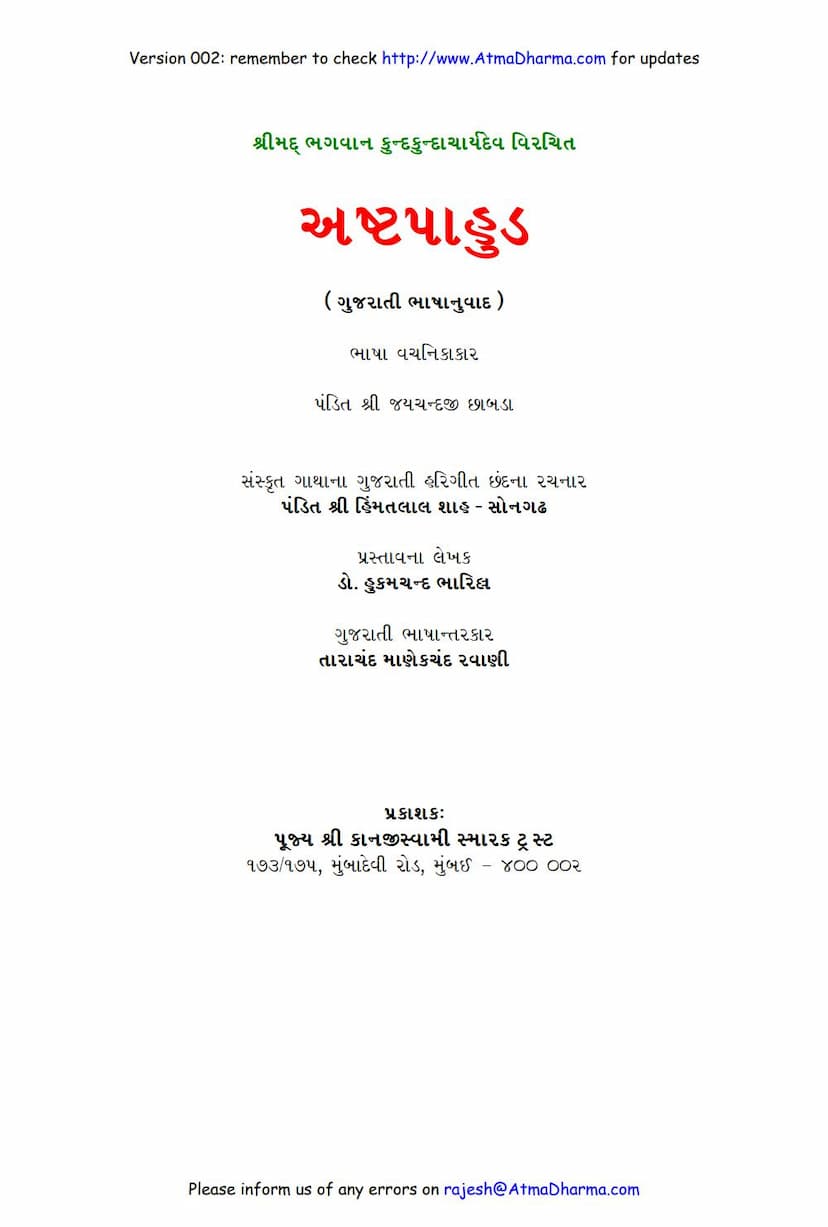Ashtapahuda
Added to library: September 1, 2025

Summary
This document is a Gujarati translation of the Jain text "Ashtapahuda" (અષ્ટપાહુડ), authored by Kundakundacharya (કુંદકુંદાચાર્ય). The translation and commentary are attributed to Tarachand Manekchand Ravani (તારાચંદ માણેકચંદ રવાણી), with a preface by Dr. Hukumchand Bharil (ડો. હુકમચંદ ભારિલ) and metrical renditions by Pandit Himmatlal Shah (પંડિત શ્રી હિંમતલાલ શાહ).
The book, published by Pujya Shri Kanjiswami Smarak Trust (પૂજ્ય શ્રી કાનજીસ્વામી સ્મારક ટ્રસ્ટ), aims to make this important Jain scripture accessible in Gujarati. The Ashtapahuda is considered a foundational text within Jainism, particularly within the Charananuyoga (the branch of Jain literature dealing with conduct). It delves into the nature of monastic life, the responsibilities and pitfalls of ascetics, and emphasizes the paramount importance of right faith (Samyakdarshan) for spiritual progress.
The text is structured into eight "Pahudas" (sections), each covering a specific aspect of Jain doctrine and practice:
-
Darshan Pahud (દર્શન પાહુડ): Focuses on the glory and importance of right faith (Samyakdarshan) as the root of all spiritual progress. It clarifies that without right faith, even extensive knowledge or ascetic practices are futile. It highlights the characteristics of true faith and warns against its absence.
-
Sutra Pahud (સૂત્ર પાહુડ): This section deals with the significance of Jain scriptures (Sutras) and the importance of following the path laid out by the Tirthankaras and their teachings. It emphasizes the need for accurate understanding and adherence to the scriptures, distinguishing them from other philosophical systems. It also touches upon the conduct of ascetics and the purity of their lineage.
-
Charitra Pahud (ચારિત્ર પાહુડ): This section is dedicated to the concept of right conduct (Charitra), classifying it into different types like Samyakcharitra and Samyamcharitra. It stresses that external practices alone are insufficient without internal purity of conduct and the sublimation of passions. The text elaborates on the importance of the three jewels (Samyakdarshan, Samyakgyan, Samyakcharitra) and how they lead to spiritual liberation.
-
Bodha Pahud (બોધ પાહુડ): This section likely deals with wisdom, enlightenment, and the understanding of the true nature of reality. It would cover topics like the distinction between the soul and the non-soul, the path to knowledge, and the means to overcome ignorance. It discusses various concepts and practices that lead to spiritual awakening.
-
Bhava Pahud (ભાવ પાહુડ): This section emphasizes the significance of internal disposition (Bhava) over external practices. It highlights that true spirituality lies in internal purity, detachment, and the cultivation of virtues, rather than merely adopting outward symbols or rituals. It stresses the importance of cultivating pure intentions and mental states.
-
Moksha Pahud (મોક્ષ પાહુડ): This is a crucial section that focuses on the ultimate goal of Jainism – liberation (Moksha). It elaborates on the path to liberation, the causes of bondage (karma), and the means to break free from the cycle of birth and death. It likely discusses the nature of the soul, the soul's true form, and the steps required to attain the highest spiritual state.
-
Linga Pahud (લિંગ પાહુડ): This section likely discusses the true meaning of external signs or appearances (Linga) in the context of spiritual life. It would differentiate between true asceticism and mere outward show, emphasizing that inner purity and conduct are paramount, regardless of external appearances. It criticizes practices that are merely performative without genuine internal transformation.
-
Shila Pahud (શીલ પાહુડ): This final section likely focuses on the concept of ethical conduct, virtue (Shila), and its integral role in spiritual development. It would emphasize the practice of virtues like non-violence, truthfulness, non-stealing, celibacy, and non-possession, and how their cultivation leads to spiritual purity and eventual liberation.
The document also includes introductory sections like "Prakashkiya Nivedan" (प्रकाशकीय निवेदन - Editorial Statement), "Vachanikakar ni Prashasti" (वचनिकाकार की प्रशस्ति - Praise of the Commentator), "Bhumika" (भूमिका - Introduction), and "Prastavana" (प्रस्तावना - Foreword), which provide context about the text, its author, translators, and its significance in Jain tradition. The foreword by Dr. Hukumchand Bharil, in particular, highlights the importance of Acharya Kundakunda and the Ashtapahuda, discussing Kundakunda's elevated status in the Digambara Jain tradition and the challenges of dating his works accurately. It also pays tribute to Pandit Jayachandra Chhabda for his significant contributions to Jain literature through his commentaries. The text concludes with a table of contents and a page listing errata.
Overall, the Ashtapahuda, as presented in this Gujarati translation, serves as a guide for aspiring spiritual seekers, particularly monks and ascetics, emphasizing the core principles of Jainism: right faith, right knowledge, right conduct, and the ultimate goal of liberation, all rooted in the importance of internal disposition and virtuous living.